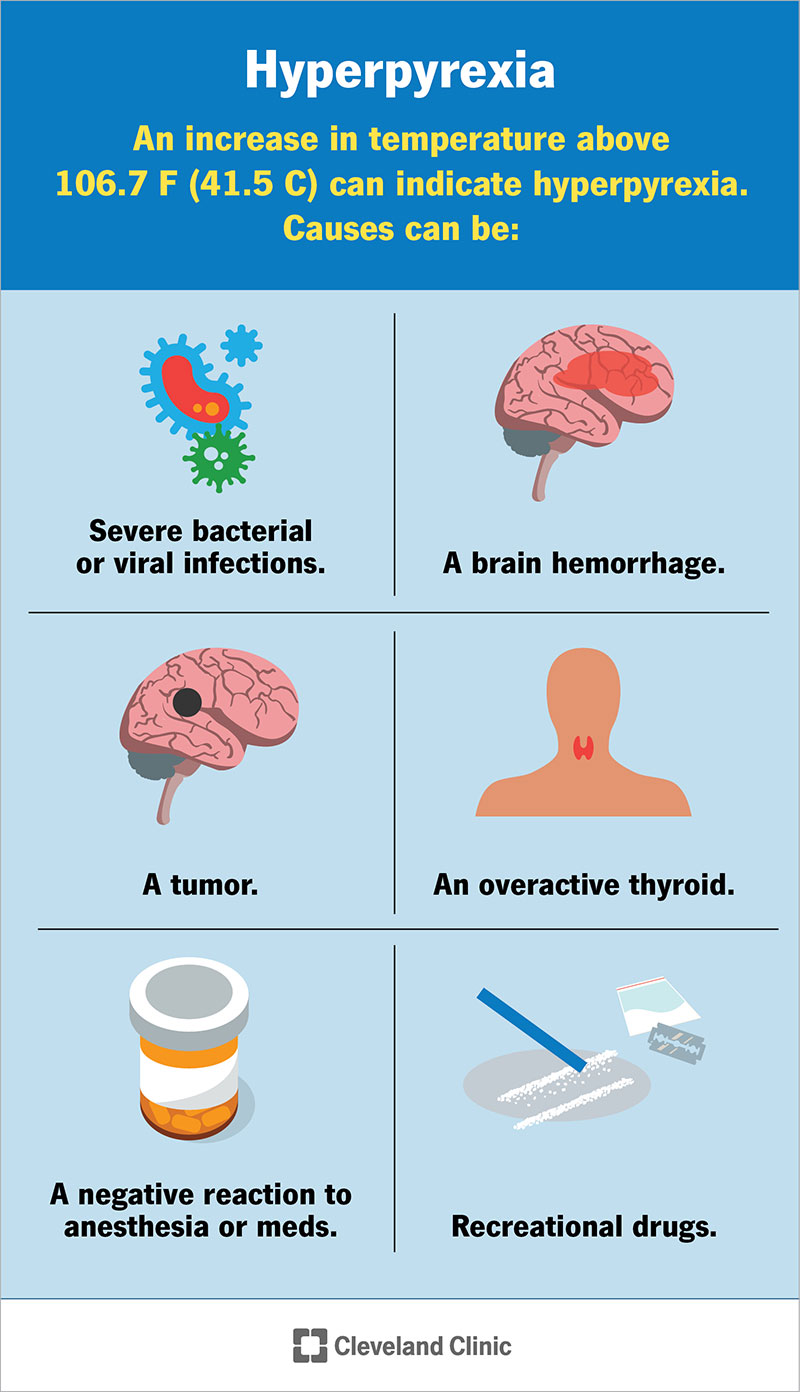Hyperpyrexia is a medical emergency that happens when your body temperature is higher than 106.7 degrees Fahrenheit (41.5 degrees Celsius). If you have a high temperature, contact emergency services immediately. Hyperpyrexia is life-threatening if untreated.
Advertisement
Cleveland Clinic is a non-profit academic medical center. Advertising on our site helps support our mission. We do not endorse non-Cleveland Clinic products or services. Policy
Hyperpyrexia is a high body temperature above 106.7 degrees Fahrenheit (41.5 degrees Celsius). This change to your body temperature happens because your brain tells it to go up.
Advertisement
Cleveland Clinic is a non-profit academic medical center. Advertising on our site helps support our mission. We do not endorse non-Cleveland Clinic products or services. Policy
Hyperpyrexia is an emergency and requires immediate medical attention.
The expected temperature of an adult human is 98.6 F (37 C). The temperature for a healthy person can range from 97.8 F to 99.1 F (36.55 C to 37.27). This range is the desired temperature on your body’s thermostat. It’s known as the “hypothalamic set point.” If you have hyperpyrexia, part of your brain changes the thermostat’s set point to increase your body temperature.
The hypothalamus is an organ in your brain that regulates your temperature. If you have hyperpyrexia, your hypothalamus increases your body temperature above what’s expected.
A healthcare provider may refer to hyperpyrexia as a “hypothalamic fever.” This is because the part of your brain that manages your temperature isn’t working correctly.
Hyperpyrexia is a body temperature above 106.7 F (41.5 C). It happens when your brain tells your hypothalamic set point to increase.
A fever is a body temperature above 100.4 F (38 C). Your hypothalamus increases your body temperature during a fever to fight off an illness or an infection.
Hyperthermia is a body temperature higher than expected (99 or 100 F / 37.2 or 37.7 C). It happens when your body absorbs more heat than it can release. It doesn’t affect the temperature set point.
Advertisement
Also, hypothermia is the opposite of hyperthermia, when your body temperature drops below 95 F (35 C).

The main symptom of hyperpyrexia is a body temperature higher than 106.7 degrees F (41.5 C). If you have a high body temperature, visit the emergency room or contact 911 (or your local emergency services number). This condition is life-threatening without quick treatment.
A high body temperature can make you feel:
If your temperature stays high, you may have severe symptoms like:
An increase in your body’s expected temperature (hypothalamic set point) causes hyperpyrexia. The temperature increase can happen due to:
The condition can be deadly if it isn’t treated quickly. Hyperpyrexia can make it hard for your organs and body systems to work, including your:
As a result, it can lead to:
As hyperpyrexia is an emergency, you’ll likely be diagnosed in the ER. A healthcare provider will check your temperature. They may check more than once and in different places on your body to make sure it’s correct. They’ll also ask about your symptoms and health history.
Testing, like blood and imaging tests, may help find the cause.
Treatment focuses on cooling down your body and treating the cause. To lower your body temperature, your care team may use the following:
Depending on the cause, additional treatment may include:
Visit the emergency room or contact 911 or your local emergency services number if you have a higher-than-normal body temperature. A body temperature above 99 or 100 degrees Fahrenheit is too warm (37.2 or 37.7 degrees Celsius). A temperature above 106.7 F (41.5 C) needs immediate medical attention.
Advertisement
Hyperpyrexia is a medical emergency. If you have a temperature above 106.7 F (41.5 C), get help right away. It can cause permanent organ damage or be life-threatening if your body temperature doesn’t lower.
Quick treatment can lead to a positive outlook. Your provider will tell you what to expect and how to take care of yourself.
You can’t prevent all causes. But you can reduce your risk by:
When your body’s temperature climbs above 106.7 degrees Fahrenheit (41.5 degrees Celsius), it’s not just a high fever; it’s a red alert. This isn’t the kind of fever that responds to rest and fluids alone. It needs fast action.
If you or someone you care for suddenly feels dizzy, confused or just “off” with a very high temperature, don’t wait it out. Get emergency care. Treatment works best when it starts right away. Quick cooling measures can protect your brain and other organs from lasting damage.
Advertisement
It’s also worth talking with your provider if you’ve had serious reactions to medications or anesthesia in the past. Knowing your medical history may help prevent complications down the road.
Advertisement
Whether you need stitches, a broken bone set or think your appendix might be causing your abdominal pain, Cleveland Clinic’s emergency medicine team is here to help.

Last reviewed on 06/07/2025.
Learn more about the Health Library and our editorial process.